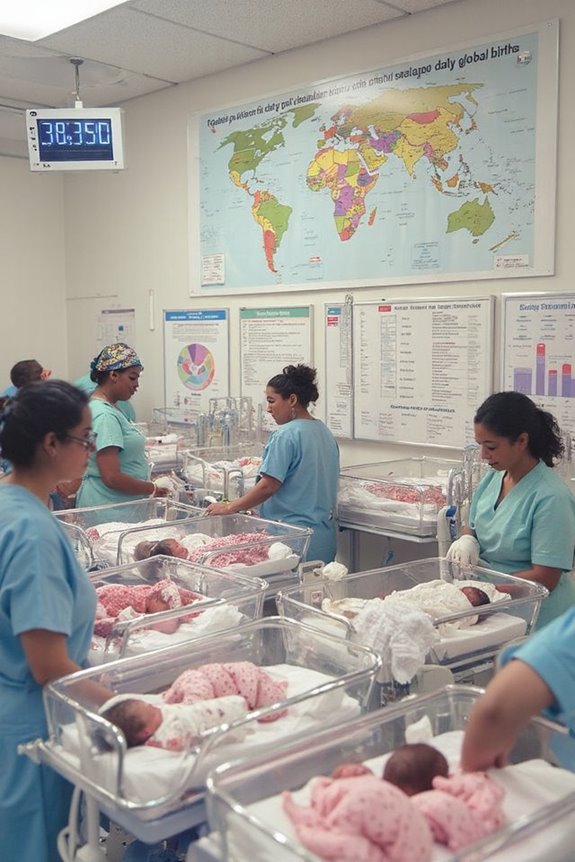Babies are created when a sperm cell from the father fertilizes an egg cell from the mother during sexual intercourse. After fertilization in the fallopian tube, the resulting zygote divides rapidly, forming a blastocyst that implants in the uterine wall. Over approximately 40 weeks, this single cell develops into a fully-formed baby through complex hormonal processes and cellular differentiation. The journey from conception to birth involves remarkable biological coordination between male and female reproductive systems. Let’s explore how this miracle unfolds.
Key Takeaways
- Babies begin with fertilization, when a sperm cell successfully enters an egg in the fallopian tube.
- After fertilization, the single-celled zygote undergoes rapid division, forming a blastocyst that implants in the uterus.
- Conception requires a viable egg (lasting 24 hours) and healthy sperm (surviving acidic environments and immune responses).
- Major organ systems begin forming during weeks 1-8, with the heart pumping blood by weeks 5-8.
- By week 10, the embryo becomes a fetus with developing organs that continue growing until birth.
The Science of Fertilization: When Egg Meets Sperm
When we talk about how babies are made, it’s important to understand the remarkable biological process of fertilization. This journey begins when sperm enter the female reproductive tract during intercourse.
Despite millions of sperm being released, intense sperm competition occurs as they travel through the cervix and uterus. Most don’t survive this journey due to:
- The acidic environment of the vagina
- Getting trapped in cervical mucus
- The body’s immune response
The few survivors must reach the fallopian tube within a specific timeframe, as egg viability lasts only about 24 hours after ovulation. Typically, fertilization occurs in the fallopian tube when a single sperm penetrates the egg’s outer layer, forming a zygote—the beginning of human development.
From Zygote to Embryo: The First Stages of Life

After fertilization occurs, the journey from a single-celled zygote to a complex embryo begins through a remarkable series of cellular divisions and transformations.
The zygote development process starts immediately after conception in the fallopian tube. This single cell, containing 46 chromosomes from both parents, undergoes rapid division as it travels toward the uterus. Within days, it forms a morula—a raspberry-like cluster of cells.
Upon reaching the uterus, the morula develops into a blastocyst with:
- An outer layer that will form the placenta
- An inner cell mass that becomes the embryo
Embryo formation advances as the blastocyst implants in the uterine wall. During the following weeks, specialized cells differentiate to create essential organ systems. By the end of the first trimester, the embryo evolves into a fetus.
The Female Reproductive System’s Essential Role

The female reproductive system represents a marvel of biological engineering, designed specifically for creating and nurturing new life. At its core are the ovaries, which serve dual functions: releasing eggs during ovulation and maintaining hormonal balance through estrogen and progesterone production.
This intricate system operates on a cyclical timeline:
- The uterus prepares monthly for potential pregnancy
- Fallopian tubes provide the pathway for egg transport and fertilization
- Hormones like FSH and LH regulate ovarian function throughout the cycle
The reproductive anatomy also includes protective structures:
- The vagina serves as both birth canal and menstrual outlet
- The cervix acts as gatekeeper to the uterus
- External structures (vulva) provide protection against infection
These components work together seamlessly to enable conception and support fetal development when fertilization occurs.
The Male Contribution to Creating New Life

Just as egg cells form the foundation of female reproduction, sperm represents the male’s essential contribution to creating new life. This microscopic cell is produced in the testes through a process called spermatogenesis.
The male reproductive system is a marvel of biological engineering:
- Sperm production occurs within the seminiferous tubules of the testes
- Newly formed sperm travels to the epididymis for maturation (about two weeks)
- Mature sperm moves through the vas deferens during ejaculation
Hormonal regulation is critical to this entire process. The brain’s pituitary gland releases FSH and LH, which signal the testes to produce testosterone and sperm. This delicate balance guarantees healthy sperm development and maintains male fertility.
When everything functions properly, millions of sperm are released during ejaculation, beginning their journey toward potential fertilization.
The Miracle of Pregnancy: Development and Growth

From the moment fertilization occurs, a remarkable journey of development begins inside a woman’s body. The fertilized egg, or zygote, undergoes rapid cell division as it travels to the uterus. Around days 6-10, this cluster of cells—now a blastocyst—implants in the uterine wall.
Key embryonic milestones include:
- Weeks 1-8: Major organ systems begin forming
- Day 17: Gastrulation creates the three foundational germ layers
- Weeks 5-8: Heart begins pumping blood and neural tube forms
By week 10, the embryo becomes a fetus, entering a phase of fetal maturation. During this time:
- Organs continue developing and becoming functional
- The brain grows rapidly
- Movements become increasingly coordinated
- Lungs prepare for breathing outside the womb
Frequently Asked Questions
How Long After Sex Can You Take a Pregnancy Test?
I recommend waiting at least 10-14 days after sex for ideal home pregnancy test accuracy. For best results, test after your missed period when hCG levels are high enough to detect reliably.
Can Twins Be Conceived on Different Days?
Yes, through a rare process called superfetation, I can tell you that twins can be conceived on different days. This creates twin conception with noticeable gestational differences, as the embryos develop at separate paces.
Why Do Some Couples Struggle With Unexplained Infertility?
Heart-wrenching as it may seem, I understand your struggle with unexplained infertility. Despite normal test results, hidden issues like sperm DNA damage or subtle anatomical problems can occur. Fertility treatments often help couples overcome these mysterious barriers.
How Does Maternal Age Affect Chromosomal Abnormalities?
As I’ve studied maternal health, I’ve found that genetic risks increase with age. My chromosomes don’t separate as efficiently when I’m older, raising the likelihood of passing abnormalities to my baby.
Can Stress or Emotions Affect Conception Chances?
Yes, I’ve found stress impact can reduce conception chances by disrupting hormones needed for ovulation. Your emotional wellbeing matters too—high stress can decrease libido and affect the timing of intercourse necessary for pregnancy.





